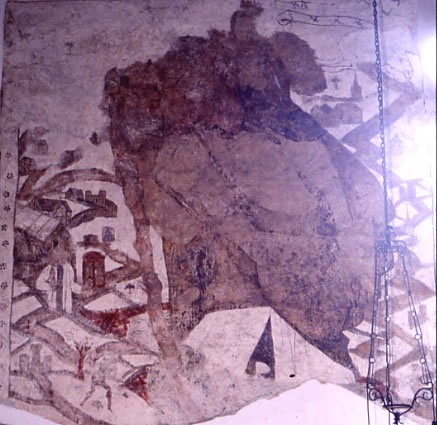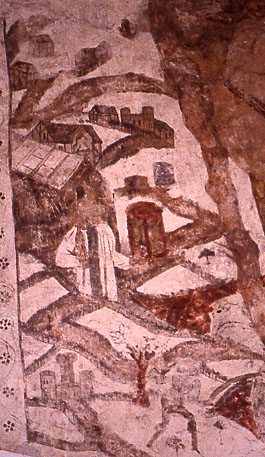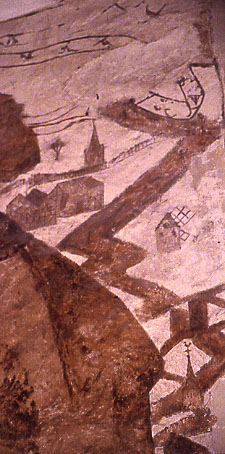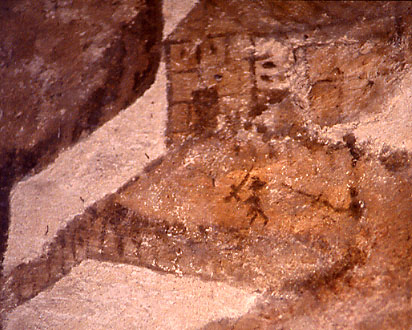Cottered, Hertfordshire (†St Albans) C.15
St Christopher

The actual figures of Christopher and the Christ Child at Cottered are now obscure and undistinguished, but the real interest here lies in the the detailed landscape background. The painting is almost four metres wide, giving ample scope for fine detail of this kind.

Some details are, by this date, largely a matter of convention, such as the hermit at the left (detail, below left) with his hugely oversized lantern. As with most hermits in St Christopher paintings, he is dressed in garments similar to those of a parish priest of the day. Buildings surround him; his own hermitage, another timbered and gabled building with a large bell hanging in its entrance at an angle to the right behind it, and others dotted here and there in the implied distance. Beyond and above him in the painting is the curved parapet of a bridge, with a tiny figure on it, and more buildings, including what may be a large fortified manor house.
Below are trees of various kinds, a man with a fishing rod, walls or fences marking out fields, and, at the bottom left, a substantial castle, possibly moated.

The right hand side of the painting, equally detailed, is shown at the right. Here at the very top, a pale, ribbon-like detail may be an unfinished scroll, rather than a continuation of the zigzag red road that features lower down. On the section of this road immediately above the windmill (only part of its sails is left), HC Whaite could see small figures which he thought belonged to a hunting party, and in fact some of these, including a running dog or a fox, can still just be made out at close quarters.¹

Two churches with spires feature in this part of the surrounding scene, the lower one clearer, with a weathercock surmounting the spire. Just below this church, completely invisible except with magnification, and shown at the left below, is a walled garden attached to a timbered building. In the garden, two men fight, apparently with swords (their size exaggerated, like the Hermit’s lantern and the giant weathercock). No hostility is necessarily implied here – this may simply be sword-and-buckler play with wooden weapons, a long-established activity frowned on as undignified by some aristocrats, but, unsurprisingly, popular among boys.
Whaite suggested that the church with the weathercock could well be a drawing of Cottered church itself (it certainly still has a spire) and the whole landscape here might be intended as a faithful representation of the village and the surrounding area. That seems to me likely, rather than merely possible, and, as so often in the later fifteenth century, the unsuccessful but obviously determined striving for three-dimensionality and perspectival recession in the landscape details is very evident.
Website of St John the Baptist, Cottered
¹ HC Whaite, St Christopher, p. 32
† in page heading = Diocese